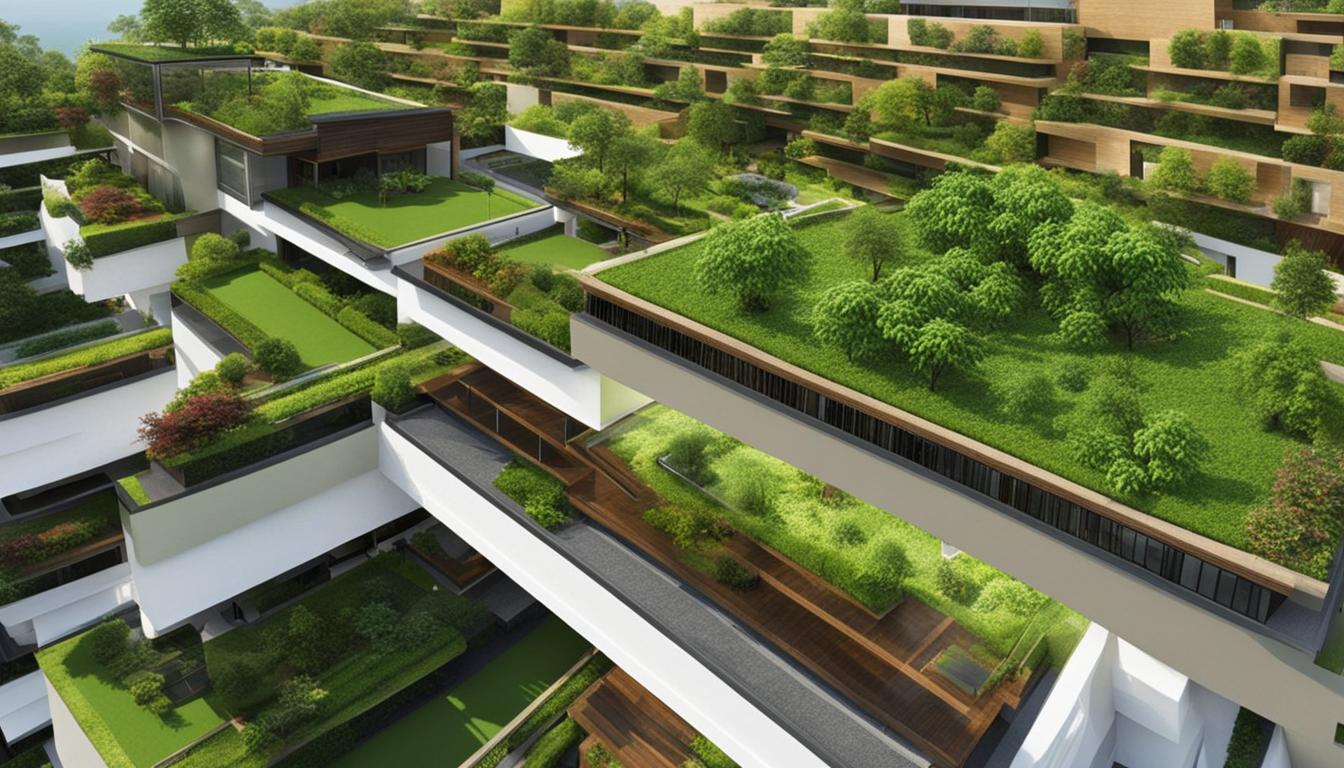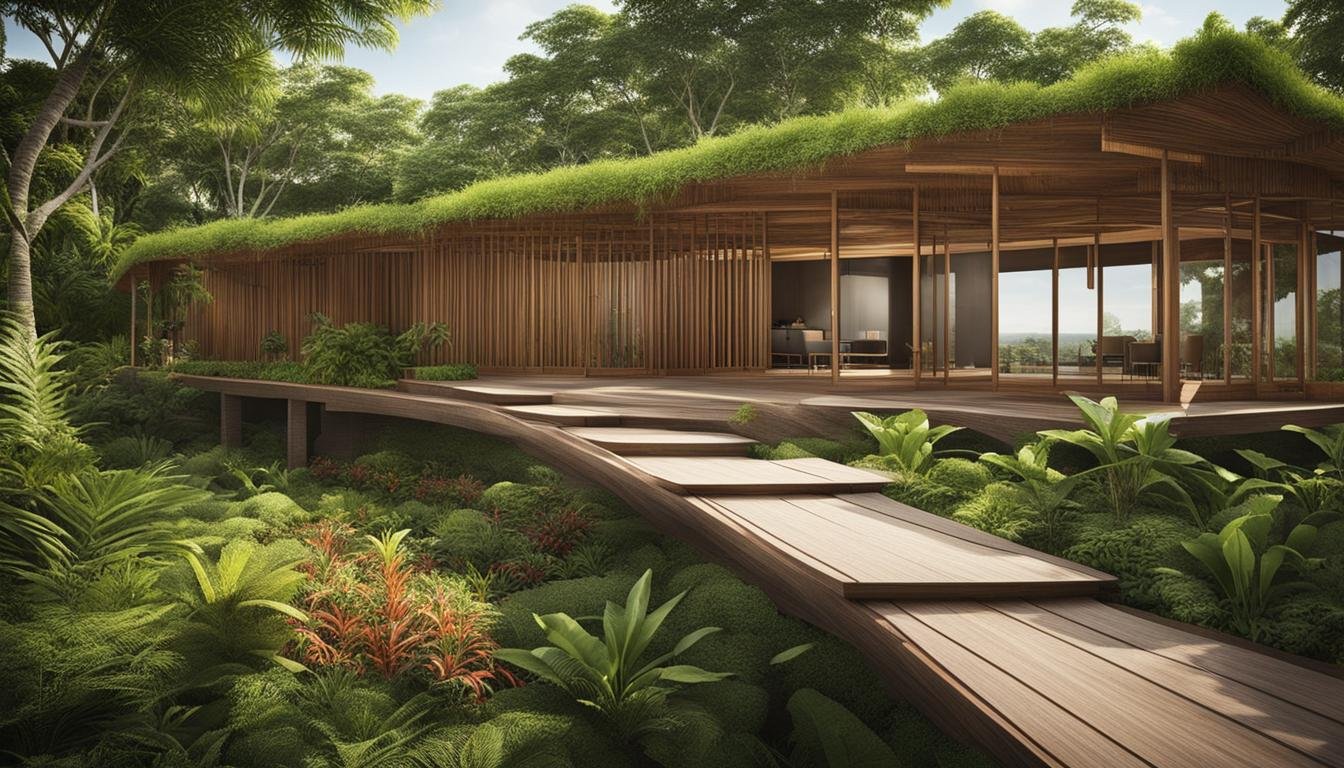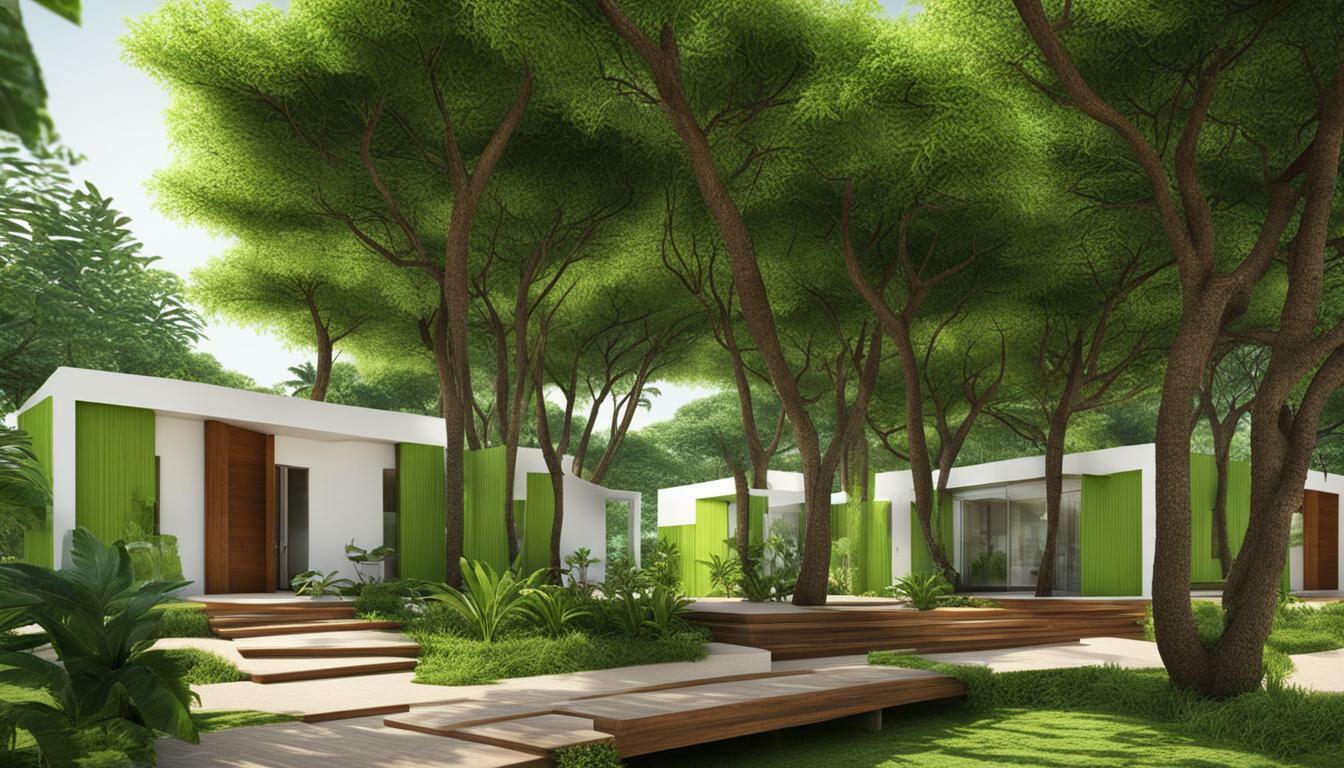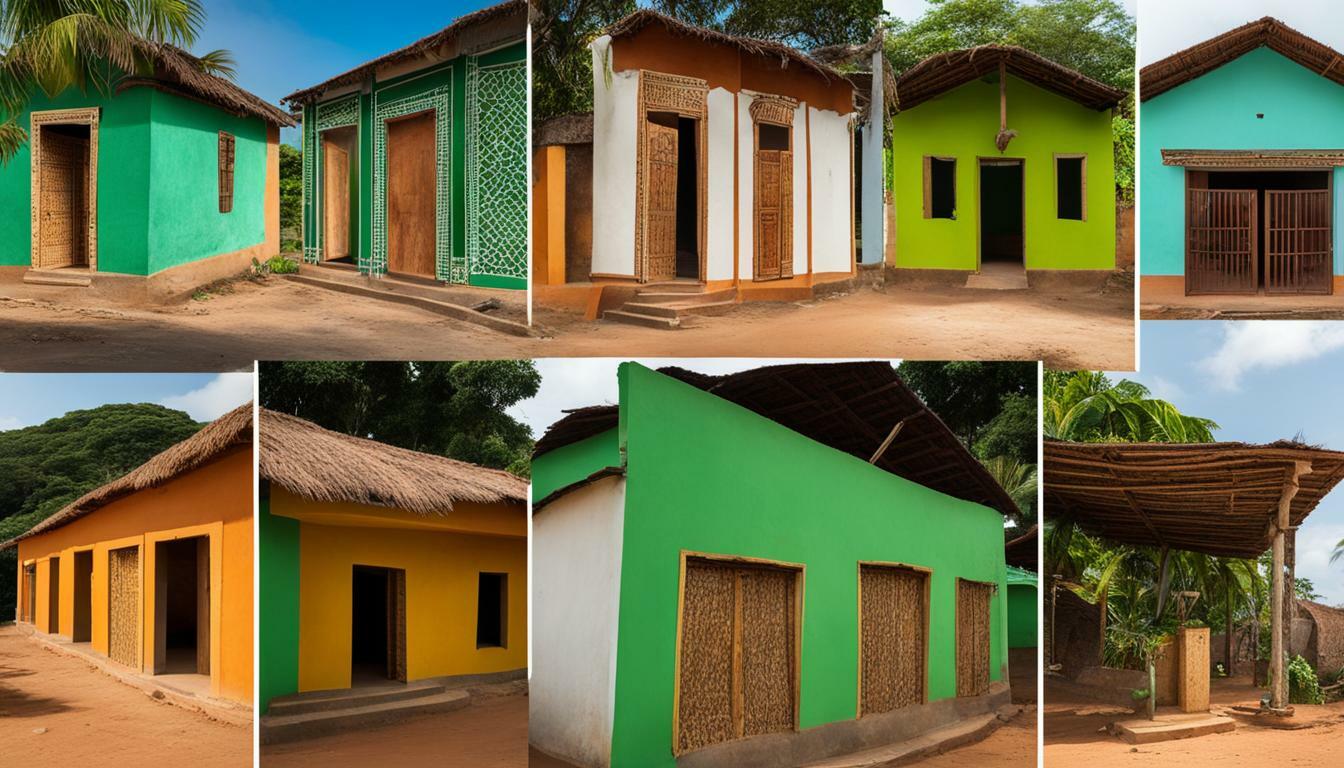Myanmar (formerly Burma) Top Green Buildings
Discover the remarkable eco-friendly buildings and sustainable architecture in Myanmar. From green building designs to environmentally friendly structures, Myanmar showcases its commitment to sustainable development and green infrastructure. Let’s explore the energy-efficient buildings and sustainable construction practices that make Myanmar a pioneer in eco-friendly architecture.
Key Takeaways
- Myanmar is home to impressive green buildings that prioritize sustainability and environmental consciousness.
- From traditional typologies to contemporary design principles, these structures blend cultural preservation with modern functionality.
- Community involvement plays a vital role in sustainable construction practices, empowering local individuals and contributing to the region’s development.
- International collaborations in areas such as asbestos removal and roofing showcase the importance of preserving Myanmar’s heritage and promoting safe construction practices.
- Myanmar’s green buildings not only provide sustainable living spaces but also support community healthcare and promote a greener future for the region.
Traditional Typologies and Materials
The design of the hospital in Magyizin, Myanmar, by A+R Architekten, draws inspiration from traditional typologies and materials found in the country’s architecture. By incorporating these elements, the design not only pays homage to Myanmar’s cultural heritage but also promotes sustainable and eco-friendly construction practices.
The hospital features a structural timber frame infilled with red bricks, a technique commonly used in traditional “brick nog” structures. This combination of materials provides a durable and visually appealing aesthetic while utilizing locally sourced resources. Additionally, the design incorporates timber vents and movable shutters to promote natural airflow and protect against rain, further enhancing the building’s sustainability.
With its integration of traditional typologies and materials, the hospital showcases how sustainable design can be achieved while respecting and preserving cultural heritage.
Table: Comparison of Traditional and Contemporary Materials
| Traditional Materials | Contemporary Materials |
|---|---|
| Red Bricks | Structural Timber Frame |
| Timber Vents | Modern Ventilation Systems |
| Movable Shutters | Energy-Efficient Windows |
“The design of the hospital in Magyizin beautifully combines traditional typologies and contemporary construction methods. It not only creates a sustainable structure but also connects the present with the past, showcasing the rich architectural heritage of Myanmar.” – Architectural Review
Incorporating traditional typologies and materials into the hospital’s design not only adds a unique aesthetic but also contributes to the overall sustainability of the building. By embracing and adapting traditional practices, architects can create structures that are both environmentally friendly and culturally significant.
Sustainable Healthcare for Rural Communities
The hospital in Magyizin, Myanmar plays a vital role in providing sustainable healthcare for rural communities in the area. With approximately 20 communities relying on this facility, it ensures that healthcare access is available even in challenging geographical conditions. Located on a hill that becomes largely inaccessible during the rainy season, the hospital’s design takes into account the needs of the local population and aims to overcome such obstacles.
To address the accessibility issue, the hospital incorporates a covered walkway that allows patients and staff to move freely even during inclement weather conditions. This walkway provides a safe and protected passage, ensuring that healthcare services remain accessible throughout the year. Additionally, the hospital’s design includes a separate isolation ward, which is crucial for managing infectious diseases and preventing their spread within the community.
Furthermore, the hospital features well-planned service spaces that cater to the specific requirements of the local population. These spaces accommodate various medical and support services, such as a laboratory for diagnostic testing and a delivery room for maternal and child healthcare. By incorporating these facilities, the hospital ensures comprehensive care for the community, addressing both immediate and long-term healthcare needs.

The sustainable healthcare infrastructure in Myanmar is crucial for improving the overall well-being of rural communities. The hospital in Magyizin serves as a testament to the country’s commitment to providing essential healthcare services, even in remote areas. By integrating sustainable practices into the design and incorporating features that address the unique challenges of rural healthcare, this facility plays a vital role in promoting health and well-being in the region.
Integration of Traditional and Contemporary Architecture
The design of the hospital in Magyizin, Myanmar seamlessly integrates traditional Myanmar architectural elements with modern features, creating a harmonious blend of past and present. Inspired by the country’s traditional “brick nog” structures, the hospital incorporates the use of red bricks and a structural timber frame, paying homage to Myanmar’s architectural heritage. At the same time, it embraces contemporary materials and techniques to ensure a sustainable and eco-friendly design.
By fusing traditional and contemporary elements, the hospital achieves a unique architectural style that reflects the cultural identity of Myanmar while meeting the functional requirements of a modern healthcare facility. This integration not only preserves the heritage of the region but also showcases the adaptability of traditional design principles in the context of contemporary architecture.
Incorporating Modern Architectural Features
The hospital’s design goes beyond the incorporation of traditional elements and also includes modern architectural features. The use of large windows and ample natural lighting creates a bright and welcoming environment for patients and staff. This not only enhances the overall aesthetics but also promotes well-being and healing through the connection with nature.
Maintaining a balance between traditional and contemporary architectural elements allows the hospital to serve as a symbol of cultural preservation while embracing the advancements of modern construction and design.
Additionally, the hospital incorporates energy-efficient systems and sustainable construction practices, such as rainwater harvesting and solar panels, to minimize its environmental impact. This holistic approach to design not only ensures the preservation of cultural heritage but also promotes responsible and sustainable development in Myanmar.

| Traditional Architecture | Contemporary Architecture |
|---|---|
| Red brick infills | Large windows for natural lighting |
| Structural timber frame | Sustainable construction practices |
| Timber vents and movable shutters for airflow | Energy-efficient systems |
Donations and Collaboration for Healthcare Equipment
In support of sustainable healthcare development in Myanmar, German healthcare institutions have generously donated essential medical equipment to the hospital in Magyizin. This collaboration demonstrates international support for improving healthcare infrastructure and ensuring access to quality medical facilities in remote areas.
The donated healthcare equipment has significantly enhanced the hospital’s capabilities in providing essential medical services to the local community. With an operating theatre, delivery room, laboratory, and 20 beds, the hospital is equipped to handle various medical needs and emergencies.
This partnership between German healthcare institutions and the local community highlights the importance of collaboration in addressing healthcare challenges and promoting sustainable development. Through these donations, the hospital can continue to deliver comprehensive healthcare services and make a positive impact on the lives of people in Magyizin and surrounding areas.

| Donated Healthcare Equipment | Quantity |
|---|---|
| Operating Theatre Equipment | 1 set |
| Delivery Room Equipment | 1 set |
| Laboratory Equipment | 1 set |
| Beds | 20 |
Community Involvement in Construction
The construction of the hospital in Magyizin, Myanmar was a collaborative effort involving the local community. Due to the absence of construction companies in the area, the building work was undertaken by local villagers under the guidance of a skilled carpenter. This community-led approach not only provided employment opportunities but also empowered the local community to actively contribute to sustainable development in their area.
Local participation in the construction process was crucial as it allowed the community to learn valuable carpentry skills and gain hands-on experience in sustainable construction practices. By involving the community in the project, the hospital became more than just a healthcare facility; it became a symbol of community empowerment and collaboration.
“The involvement of the local community in the construction of the hospital not only created a sense of ownership but also ensured that the building reflected the needs and aspirations of the people it serves,” said the project coordinator.
The successful completion of the hospital through community involvement highlights the importance of local participation in sustainable construction projects. It not only fosters a sense of pride and ownership within the community but also ensures that the built environment aligns with the cultural and social context of the area.

| Benefits of Community Involvement | Role of Communities in Sustainable Construction |
|---|---|
| Empowerment of the local community | Ensuring the project aligns with local needs and aspirations |
| Development of carpentry skills | Promoting sustainable construction practices |
| Creation of employment opportunities | Fostering a sense of pride and ownership |
The Symbolism of the Bell-Shaped Zedi
The Vipassana Meditation Center in Myanmar features a bell-shaped zedi, a traditional Buddhist pagoda, which holds deep spiritual significance. The zedi symbolizes gratitude towards Myanmar for preserving the valuable meditation techniques offered by the center. It serves as a focal point for meditation and mindfulness practices, providing a serene and tranquil atmosphere for individuals seeking spiritual growth.
“The bell-shaped zedi at the Vipassana Meditation Center is not just a physical structure; it represents our appreciation for the traditions and teachings that have been passed down through generations,” says U Kyaw Thu, the center’s founder. “It stands as a reminder of the gratitude we feel towards Myanmar and its people.”
The center is a nondenominational organization that welcomes people from all backgrounds to experience the benefits of meditation. The bell-shaped zedi, with its elegant design and rich symbolism, creates a harmonious and contemplative environment conducive to introspection and self-discovery. Visitors can explore the center’s meditation courses and engage in mindfulness practices that promote inner peace and well-being.

By integrating the bell-shaped zedi into the architectural design of the Vipassana Meditation Center, the founders have created a space where individuals can cultivate gratitude, mindfulness, and spiritual growth. The zedi stands as a visual representation of the center’s mission to provide a sanctuary for self-reflection and a path towards inner peace.
Meditation Center and Community Outreach
The Vipassana Meditation Center in Myanmar is a nondenominational organization that offers meditation courses to individuals from all backgrounds. The center provides a serene and supportive environment for people to cultivate mindfulness and experience the benefits of meditation. Courses at the center range from 10-day introductory programs to longer courses for experienced students. Additionally, specialized courses are available for children, emphasizing the importance of mindfulness practice from an early age.
The meditation center operates on a donation basis, ensuring that people from different socio-economic backgrounds can access the courses. This inclusive approach enables individuals to prioritize their mental well-being without financial barriers. The center’s commitment to community outreach extends beyond its meditation courses. It actively engages with local communities to spread the benefits of mindfulness and meditation through various initiatives.
Community Outreach Programs
Through community outreach programs, the Vipassana Meditation Center aims to create a positive impact on individuals and communities. These programs may include workshops, seminars, and mindfulness sessions conducted in partnership with local organizations and institutions. By collaborating with the community, the center aims to promote mental well-being, stress reduction, and personal growth.
“Meditation allows us to connect with ourselves and the world around us. It brings clarity, peace, and compassion into our lives,” says the center’s spokesperson.
The center also encourages participants to take what they have learned back to their communities, fostering a ripple effect of mindfulness and positivity. By empowering individuals with the tools to manage their own mental well-being, the center contributes to the overall health and resilience of the community.
| Benefits of Vipassana Meditation Center | Community Outreach Programs |
|---|---|
| 1. Cultivation of mindfulness | 1. Workshops and seminars |
| 2. Stress reduction | 2. Mindfulness sessions |
| 3. Personal growth | 3. Collaboration with local organizations |
| 4. Inclusive donation-based system | 4. Empowering individuals to share knowledge |
The Vipassana Meditation Center in Myanmar is a sanctuary for individuals seeking to cultivate mindfulness through meditation. By offering accessible courses and engaging with the community through outreach programs, the center promotes mental well-being and personal growth on both an individual and community level.

Collaboration for Asbestos Removal and Roofing
The preservation of Myanmar’s heritage is an international effort, as demonstrated by the collaboration between the World Monument Fund and experts from various countries. One such project involved addressing asbestos removal and roofing at the historic First Baptist Church in Mawlamyine, Myanmar. Experts from Australia, Japan, Syria, and other nations came together to assess the church’s roof and propose safe replacement practices, ensuring the preservation of Myanmar’s architectural legacy.
The partnership between the World Monument Fund and international experts highlights the importance of cross-border collaboration in heritage preservation. By combining diverse expertise and perspectives, the project aimed to find innovative solutions for the removal of asbestos and the installation of a new roofing system. This collaboration not only ensures the safety and longevity of the church but also promotes the use of safe construction practices in Myanmar.
“Preserving Myanmar’s architectural heritage requires a collective effort and knowledge exchange. Our collaboration with experts from different countries not only ensures the preservation of historic buildings but also promotes cultural exchange and the sharing of best practices in safe construction.” – World Monument Fund
Table: Collaboration Details
| Collaborating Countries | Role | Expertise |
|---|---|---|
| Australia | Asbestos Removal | Safe practices and disposal methods |
| Japan | Roofing Design | Traditional and contemporary roofing techniques |
| Syria | Structural Assessment | Expertise in historic building preservation |
| Other Countries | Collaborative Support | Knowledge exchange and project coordination |
The international collaboration for asbestos removal and roofing at the First Baptist Church in Mawlamyine not only showcases the dedication to Myanmar’s heritage preservation but also serves as a model for future projects. By bringing together experts from different countries, the project promotes the exchange of knowledge, cultural understanding, and the implementation of safe construction practices. It is through such collaborations that the world can come together to safeguard the architectural treasures of Myanmar and ensure their continued appreciation for generations to come.

Conclusion
Myanmar’s commitment to sustainable development and eco-architecture is evident in its top green buildings. These architectural marvels blend traditional typologies with contemporary design principles, resulting in unique structures that not only preserve the country’s rich cultural heritage but also promote modern functionality.
With a focus on eco-architecture, these green buildings provide sustainable living spaces that prioritize environmental consciousness. By incorporating green building designs, Myanmar showcases its dedication to sustainable living and the preservation of natural resources. These structures serve as beacons of sustainable development, inspiring other nations to follow suit.
Furthermore, these buildings go beyond just architectural brilliance. They play a crucial role in supporting community healthcare by providing accessible and sustainable healthcare facilities. Through the integration of healthcare infrastructure and sustainable design, these green buildings contribute to the overall well-being of the local population.
Myanmar’s top green buildings stand as a testament to the possibilities of sustainable construction and design in the region. They demonstrate that it is possible to create spaces that are not only visually stunning but also environmentally friendly and culturally significant. With their commitment to eco-architecture, sustainable living, green building designs, community healthcare, and cultural preservation, Myanmar paves the way for a greener and more sustainable future.
FAQ
What are some examples of Myanmar’s top green buildings?
Some examples of Myanmar’s top green buildings include the hospital in Magyizin, the Vipassana Meditation Center, and the First Baptist Church in Mawlamyine.
What is the significance of integrating traditional typologies and materials in Myanmar’s green buildings?
By integrating traditional typologies and materials, Myanmar’s green buildings blend cultural preservation with modern architectural features, creating sustainable and eco-friendly structures.
How does the sustainable healthcare infrastructure in Myanmar benefit rural communities?
The healthcare infrastructure in Myanmar, such as the hospital in Magyizin, ensures healthcare access for rural communities, providing essential medical services to approximately 20 communities in the area.
How do Myanmar’s green buildings seamlessly integrate traditional and contemporary architectural design?
Myanmar’s green buildings draw inspiration from traditional architectural styles, such as the “brick nog” structures, while incorporating modern materials and techniques, resulting in a contemporary design vocabulary.
How are donations and collaborations contributing to the healthcare facilities in Myanmar?
Donations from institutions in Germany have provided healthcare equipment for facilities like the hospital in Magyizin, showcasing international support for sustainable healthcare development in Myanmar.
What is the role of community involvement in sustainable construction practices in Myanmar?
Community-led construction, as seen in the building of the hospital in Magyizin, not only provides employment opportunities but also empowers the local community to actively contribute to sustainable development in their area.
What is the symbolism of the bell-shaped zedi at the Vipassana Meditation Center in Myanmar?
The bell-shaped zedi represents gratitude to Myanmar for preserving the meditation technique offered by the center and serves as a focal point for meditation and mindfulness practices.
What programs does the Vipassana Meditation Center offer besides meditation courses?
The Vipassana Meditation Center offers 10-day meditation courses, longer courses for experienced students, and even courses for children. It operates on a donation basis and provides community outreach programs to spread the benefits of meditation.
How is international collaboration contributing to heritage preservation and safe construction practices in Myanmar?
The collaboration between the World Monument Fund and international experts has helped address asbestos removal and roofing issues at the First Baptist Church in Mawlamyine, promoting safe construction practices and preserving Myanmar’s heritage.
What is the overall impact of Myanmar’s top green buildings on sustainable living, community healthcare, and cultural preservation?
Myanmar’s top green buildings exemplify sustainable construction and design in the region, providing eco-friendly living spaces, supporting community healthcare, and blending cultural preservation with modern functionality.








